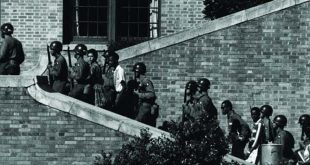Paying off families of murdered black men is an American custom not replicated in the rest of the world. The payment of “blood money”, million-dollar restitution by states or municipalities for crimes committed in their name by the police shifts the onus and blame from the perpetrators to society at large. The financial burden for this culture of immunity and impunity is never paid by the police departments or individual officers responsible. This should not be allowed.
The reverse side of the coin also fuels the divisive conflict between “us” and “them”. When a white policeman or state trooper is gunned down in cold blood the best that the state or municipality will do, after the media event, the funeral, the moment of silence and other expressions of hypocrisy, is live up to a collective bargaining agreement and pay the widow and survivors meager death benefits.
The formula used to determine monetary damages for wrongful death, the so-called “pecuniary loss” or the “valuation by human capital” rule is nothing more than a simple calculation of “the monetary amount the victim could have provided for surviving family members, based upon income at time of death and average work-life expectancy” and “reasonable compensation for the pain and suffering, while conscious, undergone by the deceased during the period intervening between the time of injury and death”. This leads to a racial and cultural divide that is best understood by applying the case study method.
Case study No. 1: Staten Island resident Eric Garner was a 6’ 3” 350-pound 43-year-old unemployed married African American in poor health. At the time of his death July 17, 2014, he was out on bail for selling untaxed cigarettes, driving without a license, marijuana possession and false impersonation. On July 13, 2015 without the filing a complaint the City of New York reached a settlement valuing his life at $5.9 million dollars.
New York City Police Officer Brian Moore was shot dead while on duty on May 4, 2015 in Jamaica, Queens. He was a 5-year veteran on the force with a salary of some $69,000. His death benefits, that is the value that the City put on his life and was willing to pay was “a New York City-paid pension based on 50% of final average salary” $5,833.33 or $486.11 a month for life to a designated beneficiary supplemented by a New York State special accidental death benefit which I calculate at $325,000.
The $5.9 million paid the Garner family does not reflect the pecuniary loss sustained. It was blood money paid by the City of New York to salve the community’s conscience. The $486.11 per month pension paid the Police Officer Moore’s spouse is an insult and the special accidental death benefit modest.
Case study No. 2: On October 20, 2014 Laquan McDonald a 17-year old black teenager was shot 16 times in the space of 13 seconds by Jason Van Dyke a 14-year veteran of the Chicago Police Department. McDonald was high school student and ward of the state with a troubled past which included multiple juvenile and drug possession arrests and school expulsions. Van Dyke was a police officer with at least 20 citizen complaints for use of excessive force and firearm misuse. A jury awarded one complainant $350,000 for use of excessive force during a traffic stop and “may have been involved in the cover-up of a shooting in 2005”.
Before the family could file a wrongful death action and before the video of the cold blooded murder was made public the Chicago City Council approved a $5 million settlement with the proviso that “the video be sealed until the investigation was completed” – that provision was negated by a court order compelling public disclosure. Chicago valued the life of a black unemployed troubled teenager at $5 million.
Had Officer Van Dyke who was earning $78,012 a year been killed in the incident, as a married 14-year veteran with two children, his death benefits would have been, as best as I can figure, $653, 270.40 [$333,604.68 Survivor Death Benefits DOJ and $320,165.72 Illinois State Line of Duty Compensation]. That’s a huge $4.4 million discrepancy in valuation.
Case study No. 3: On April 12, 2015 Freddie Carlos Gray was arrested for possession of an illegal switchblade. While in custody and while being transported in a Baltimore Police Department van he sustained injuries and died from injuries to his spinal cord. Six police officers were indicted. Notwithstanding Gray’s death 3 were found not guilty and exonerated while charges against the remaining 3 were dropped.
Gray was not employed at the time of his death. He had a criminal record, had been sentenced to 4 years in jail for drug possession with intent to sell and was out on bail. Baltimore settled before being sued for $6.4 million publicly stating that it “should not be interpreted as a judgment on the guilt or innocence of the officers”.
The median annual salary for a Baltimore police officer is $54,012.00 with death in the line of duty benefit to the surviving spouse of “a pension of 100% of the employee’s current salary for life”. A surviving spouse would have to survive her dead policeman husband 118 years to receive the $6.4 that the Gray estate settled for.
While over compensating victims of police killings is uniquely American, the killings of civilians by the police is universal. In May the European Court of Human Rights decided that police officers who shot and killed Jean Charles de Menezes, a Brazilian electrician in Stockwell Station, London should not be held accountable and did not violate “article two of the convention which guarantees the right to life” even though he was shot seven times in the head and once in the shoulder in less than 30 seconds. Go figure.
The digital cyber age of dashboard cameras and smartphones has documented police murder and manslaughter. The use of the perjured “he said”, “she said” defense no longer flies. The closing the ranks, the thin blue line defense of collective immunity must be discarded.
You can’t do much about the criminal responsibility of either civilian or police killers. The criminal standards of culpability are fair and appear neutral favoring neither civilian nor officer. It is their application that requires constant monitoring and vigilance.
Black, brown or white victims of police abuse and use of excessive force resulting in death and permanent injury should be fairly compensated. The “pecuniary loss” or “valuation by human capital” rule must be applied uniformly. “Blood Money”, collective guilt compensation paid by states and municipalities should be forbidden. Any compensation paid victims should first be assessed against the individual police officer or officers adjudged culpable or complicit.
Only after individual assets are exhausted to the point of bankruptcy should the state step in, as an insurer of last resort, and compensate the victims. The police will then be forced to police themselves – who better to guard the guardians?
 Deyan Ranko Brashich is a contributor writing from New York. He is the author of Letters from America, Contrary Views and Dispatches. His contact and blog “Contrary Views” is at www.deyanbrashich.com
Deyan Ranko Brashich is a contributor writing from New York. He is the author of Letters from America, Contrary Views and Dispatches. His contact and blog “Contrary Views” is at www.deyanbrashich.com
 Печат – Лист слободне Србије Политички недељник, актуелна политичка дешавања, друштво, свет, култура.
Печат – Лист слободне Србије Политички недељник, актуелна политичка дешавања, друштво, свет, култура.







